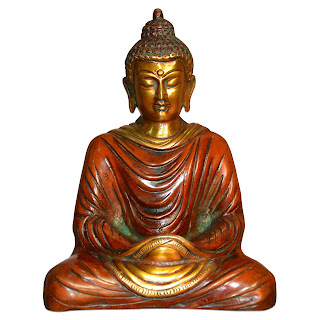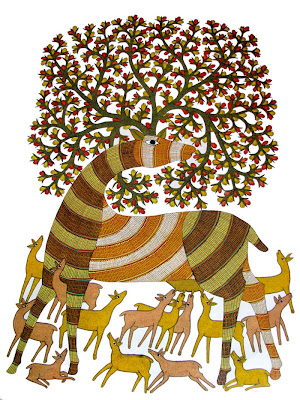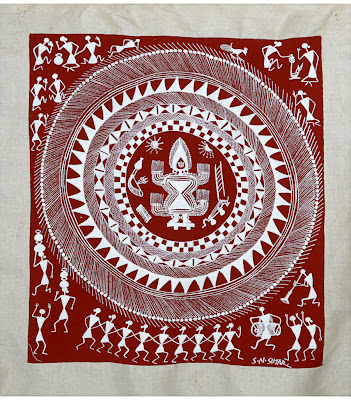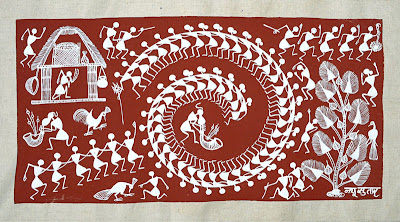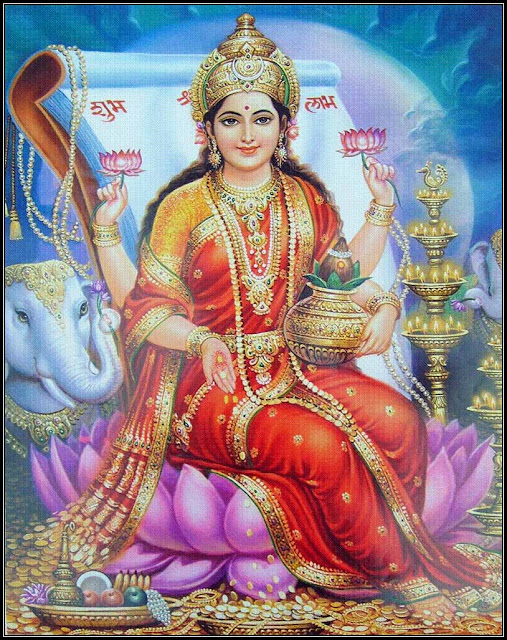Buddhism as a way of life was adopted by several rulers of the Indian subcontinent. Large institutions and religious centres were established with this patronage. Several years after the Buddha's death two major branches of Buddhist thought emerged: one called Hinayana, the little vehicle, and the other Mahayana, the great vehicle that carries one to salvation.
From the Indian subcontinent the teachings of the Buddha spread to neighbouring Sri Lanka, the north-west frontier, Myanmar(Burma), Thailand, Indonesia, China, Korea and finally to Japan. In the 10th and 12th centuries, as Muslim armies began to conquer territories in India, several Buddhist institutions were destroyed. Idol worship, not permissible under Islam, came under threat and Buddhist monks fled from mainland India to shelter in the Himalayan mountains. In time, these retreats, in the valleys of Tibet, Bhutan, Nepal and Ladakh in India, became famous centres of learning. Here, manuscripts, sciences and rituals and the gentle way of the Buddha were preserved over the centuries.
My Indian Culture
Indian Culture, Indian Heritage, Indian Fashion, Indian Folk Arts, Indian Handicrafts, Religion and Spirituality
Monday, November 25, 2013
Sunday, December 25, 2011
Indian Folk Art & Tribal Art Paintings Styles
There are different types of tribal & folk paintings all over India and each of the styles are different from the others. Some of the basic paintings India as warli, batik, madhubani, miniature and many others. Folk art is an integral part of everyone's life in India, where you get to cross inside the temples. Paintings of India have adopted various techniques and styles on their journey into the world of the arts. Cave paintings are valuable visual documents of history.
Miniature Art - Miniature Paintings are practiced in Jaipur and Bikaner regions of Rajasthan. Miniatures paintings are intricate, colorful handmade illuminations or paintings, small in size, executed meticulously with delicate brushwork. The colors used in the Asian art miniatures are derived from minerals, vegetables, precious stones, indigo, conch shells, pure gold and silver. These Asian art miniatures recreate historical episodes or tales of mythology in Schools that have come to be identified with the different kingdoms that merged in Rajasthan. Fine brush strokes signify miniatures from Jaipur and Udaipur. The colorful illuminations, which captured the fancy of the royalty and aristocracy, emerged in the medieval period. The illustrated manuscripts of Jains and Buddhists, and the flowering of the Mughal, Rajput, and Deccan Miniatures are noted for their meticulous execution and artistic skills.
The fine stroke of brushes conveyed the themes from the Ramayana, Mahabharata, Bhagvata Purana, Rasikpriya, Rasamanjiri, etc.These masterpieces of yore have a universal appeal which still touches the right chord of the audience. The irony of history never ceases to amaze. The mighty Himalayas nurtured in its western valleys, a School of Paintings known as the “Miniature”.
Batik Art - Batik art of India Asian paintings come from Bengal. Batik art refers to the art of dyeing fabric by making use of resist techniques, covering areas of cloth with a dye resistant substance to prevent them from absorbing colors. The technique of Batik art dates back a thousand years and can be traced to India.
Batik art is created in several ways like splash method, screen printing method, and hand painting one is by a Kalamkari pen. As patterns are applied by actual drawing rather than by weaving with thread, the artists can put forth their best in terms of creativity and imagination. The Batik art fabric is in high demand as dress materials, designer home decor and also as forming an important part of contemporary fashion accessory.
Gond Paintings - Tribal art of India Gond paintings of Madhya Pradesh, specially the wall paintings of Bundelkhand, Gondwana, Nimar and Malwa are living expressions of the village people, deeply linked with their day to day lives. They are not mere decorations but also instant expressions of their religious sentiments and devotions.
The tribal folk art gond paintings, based on local Indian festivals like Karwa Chauth, Deepawali, Ahoi Ashtami, Nag Panchmi, Sanjhi etc. are done by women using simple homemade colors. In the Gondwana region, the Gond and the Pardhan tribes who have impressed audiences at exhibitions in Japan, France , Australia and other countries, have showed unmatched creative vision. A community of professional artists does the paintings. Horses, elephants, tigers, birds, gods, men and objects of daily life are painted in bright and multicolored hues.
Kalamkari Painting - Folk art of India Kalamkari painting is pen drawings on cloth. Andhra Pradesh are famed for Kalamkari paintings. This folk art form derives its name from kalam or pen, which is used to trace outlines patterns and images. The Kalamkari technique involves drawing outlines with burnt tamarind twigs dipped in molasses and iron fillings.
The vegetables dyes of deep shades are used to create religious scenes. The final effect comes with repeating the process of coloring. The uniqueness of these painting is that no two panels are similar. Vegetable and mineral pigments are used to create these paintings. The artists believe in using natural dyes, extracted from bark, flower and root. One would be stunned to know that the colour red is obtained by using the Indian madder root, yellow from the pomegranate seed or even mango bark, and black from myrobalam fruit. The process used for both schools of Kalamkari painting is more or less the same. The only major difference is that Srikalahasti paintings depend entirely on the brush-like pen whereas the Masulipatnam style uses block-printing procedures. The process done in Srikalahasti is more tedious. The cloth is treated and washed twice, and two or three times alum is painted.
Madhubani Paintings - Rare Indian Art and Crafts From a Village in India Madhubani Paintings From North India. Madhubani is a small village in Bihar, in India. This undistinguished little village is the heartland of the internationally acclaimed school of folk art painting called 'Madhubani' or 'Mithila' painting. Themes revolve around Hindu Gods and mythology, along with scenes from the royal court and social events like weddings.
Generally no space is left empty; the gaps are filled by paintings of flowers, animals, birds, and even geometric designs. Colors applied have no shading. Normally a double line is drawn for the outlines, with the gap between the lines filled by cross or tiny straight lines. In the linear painting, no colors are applied. Only the outlines are drawn. Often, a coat of whitewash is also applied before actually starting the painting. Traditionally, natural colors obtained from plant extracts are used.
Patachitra Paintings - An annual ritual in the famous Jagannath Temple of Puri, a beach town in the State of Orissa, has given rise to one of India's most treasured folk art form, the 'Patachitra'. The origin of the Patachitra paintings can be traced back to the 8th century AD and it is considered as one of the earliest forms of indigenous paintings.
Originating as a ritual, the Patachitra is regarded today as one of the most cherished collectors' items. Although several centuries old, Patachitra continues to be a living art form practiced even today.
Mandala Paintings - Mandala paintings are spirtual buddhist folk art paintings . Mandala with Amitayus Amitabha as the highest deity. The leaves around him also symbolize the instance of his Enlightenment. Amitayus, literally meaning unlimited life, is what Buddha is called in this form.
He is regarded as the God of longevity. The ambrosia vase that is placed on his left palm is his special emblem. His right hand touches the ground while he sits in lotus posture.
Tribal Art Warli -Warli or Worli art always contains groups of people. The themes chosen by the artists are mainly from nature. Harvest is one of their major themes. One other very popular theme is that of a wedding festival. These paintings are mainly created on mud walls of tribal houses. Women are mainly engaged in the creation of these paintings.
Warli paintings express everyday life using extremely basic object forms and just one color - white - on an austere mud base. The painting style is close to pre-historic cave paintings. Warli paintings serve the social and religious aspirations of the people. These paintings do not depict mythological characters or images of deities, but depict social life. Images of human beings and animals, along with scenes from daily life are created in a loose rhythmic pattern.
Miniature Art - Miniature Paintings are practiced in Jaipur and Bikaner regions of Rajasthan. Miniatures paintings are intricate, colorful handmade illuminations or paintings, small in size, executed meticulously with delicate brushwork. The colors used in the Asian art miniatures are derived from minerals, vegetables, precious stones, indigo, conch shells, pure gold and silver. These Asian art miniatures recreate historical episodes or tales of mythology in Schools that have come to be identified with the different kingdoms that merged in Rajasthan. Fine brush strokes signify miniatures from Jaipur and Udaipur. The colorful illuminations, which captured the fancy of the royalty and aristocracy, emerged in the medieval period. The illustrated manuscripts of Jains and Buddhists, and the flowering of the Mughal, Rajput, and Deccan Miniatures are noted for their meticulous execution and artistic skills.
The fine stroke of brushes conveyed the themes from the Ramayana, Mahabharata, Bhagvata Purana, Rasikpriya, Rasamanjiri, etc.These masterpieces of yore have a universal appeal which still touches the right chord of the audience. The irony of history never ceases to amaze. The mighty Himalayas nurtured in its western valleys, a School of Paintings known as the “Miniature”.
Batik Art - Batik art of India Asian paintings come from Bengal. Batik art refers to the art of dyeing fabric by making use of resist techniques, covering areas of cloth with a dye resistant substance to prevent them from absorbing colors. The technique of Batik art dates back a thousand years and can be traced to India.
Batik art is created in several ways like splash method, screen printing method, and hand painting one is by a Kalamkari pen. As patterns are applied by actual drawing rather than by weaving with thread, the artists can put forth their best in terms of creativity and imagination. The Batik art fabric is in high demand as dress materials, designer home decor and also as forming an important part of contemporary fashion accessory.
Gond Paintings - Tribal art of India Gond paintings of Madhya Pradesh, specially the wall paintings of Bundelkhand, Gondwana, Nimar and Malwa are living expressions of the village people, deeply linked with their day to day lives. They are not mere decorations but also instant expressions of their religious sentiments and devotions.
The tribal folk art gond paintings, based on local Indian festivals like Karwa Chauth, Deepawali, Ahoi Ashtami, Nag Panchmi, Sanjhi etc. are done by women using simple homemade colors. In the Gondwana region, the Gond and the Pardhan tribes who have impressed audiences at exhibitions in Japan, France , Australia and other countries, have showed unmatched creative vision. A community of professional artists does the paintings. Horses, elephants, tigers, birds, gods, men and objects of daily life are painted in bright and multicolored hues.
Kalamkari Painting - Folk art of India Kalamkari painting is pen drawings on cloth. Andhra Pradesh are famed for Kalamkari paintings. This folk art form derives its name from kalam or pen, which is used to trace outlines patterns and images. The Kalamkari technique involves drawing outlines with burnt tamarind twigs dipped in molasses and iron fillings.
The vegetables dyes of deep shades are used to create religious scenes. The final effect comes with repeating the process of coloring. The uniqueness of these painting is that no two panels are similar. Vegetable and mineral pigments are used to create these paintings. The artists believe in using natural dyes, extracted from bark, flower and root. One would be stunned to know that the colour red is obtained by using the Indian madder root, yellow from the pomegranate seed or even mango bark, and black from myrobalam fruit. The process used for both schools of Kalamkari painting is more or less the same. The only major difference is that Srikalahasti paintings depend entirely on the brush-like pen whereas the Masulipatnam style uses block-printing procedures. The process done in Srikalahasti is more tedious. The cloth is treated and washed twice, and two or three times alum is painted.
Madhubani Paintings - Rare Indian Art and Crafts From a Village in India Madhubani Paintings From North India. Madhubani is a small village in Bihar, in India. This undistinguished little village is the heartland of the internationally acclaimed school of folk art painting called 'Madhubani' or 'Mithila' painting. Themes revolve around Hindu Gods and mythology, along with scenes from the royal court and social events like weddings.
Generally no space is left empty; the gaps are filled by paintings of flowers, animals, birds, and even geometric designs. Colors applied have no shading. Normally a double line is drawn for the outlines, with the gap between the lines filled by cross or tiny straight lines. In the linear painting, no colors are applied. Only the outlines are drawn. Often, a coat of whitewash is also applied before actually starting the painting. Traditionally, natural colors obtained from plant extracts are used.
Patachitra Paintings - An annual ritual in the famous Jagannath Temple of Puri, a beach town in the State of Orissa, has given rise to one of India's most treasured folk art form, the 'Patachitra'. The origin of the Patachitra paintings can be traced back to the 8th century AD and it is considered as one of the earliest forms of indigenous paintings.
Originating as a ritual, the Patachitra is regarded today as one of the most cherished collectors' items. Although several centuries old, Patachitra continues to be a living art form practiced even today.
Mandala Paintings - Mandala paintings are spirtual buddhist folk art paintings . Mandala with Amitayus Amitabha as the highest deity. The leaves around him also symbolize the instance of his Enlightenment. Amitayus, literally meaning unlimited life, is what Buddha is called in this form.
He is regarded as the God of longevity. The ambrosia vase that is placed on his left palm is his special emblem. His right hand touches the ground while he sits in lotus posture.
Tribal Art Warli -Warli or Worli art always contains groups of people. The themes chosen by the artists are mainly from nature. Harvest is one of their major themes. One other very popular theme is that of a wedding festival. These paintings are mainly created on mud walls of tribal houses. Women are mainly engaged in the creation of these paintings.
Warli paintings express everyday life using extremely basic object forms and just one color - white - on an austere mud base. The painting style is close to pre-historic cave paintings. Warli paintings serve the social and religious aspirations of the people. These paintings do not depict mythological characters or images of deities, but depict social life. Images of human beings and animals, along with scenes from daily life are created in a loose rhythmic pattern.
Tags:
Batik Art,
Buddhist Art,
Ethnic Paintings,
Folk Art,
Gond Paintings,
Kalankari Paintings,
Madhubani,
Miniature Paintings,
Tribal Art
Location:
Mumbai, Maharashtra, India
Tuesday, December 13, 2011
Stainless Steel Kitchen Utensils, Serve-ware, Tableware, Cutlery and Dinner Set
In ancient time to modern time Indian food preparation utensils are vary from clay or terracotta, brass, copper, bronze, aluminium, iron to stainless steel and even in precious metal like gold & silver.
These days stainless steel products are designed and constructed with full understanding of the product's use, the design process draws on decades of experience in providing kitchenware that are both durable and elegant as copper ware were produced for Indian cuisine in earlier time.
Stainless Steel is a composite of different steels and varies in terms of grades for different uses.This set was specifically designed for those who are serious about good health and good cooking. All pieces have a polished finish on the outside and easy grip handles.
Utensils such as knives, forks, and spoons used as tableware are collectively known as cutlery. Cutlery adds beauty to any table. Also referred to as tableware, cutlery implements for cutting and eating food. They refer to any hand utensil used for preparing, serving and especially eating food. A classic design with softly rounded lines which fit perfectly in the hand. An elegant and practical cutlery available in stainless steel. A stylish and practical model with a mat finish.Timeless design which with its simple form and shape has developed into a classic.Cutlery that in a modern and simple form, inspired by ancient Nordic language with a combination of an elegant form. The rust-proof stainless steel is used to churn out an impressive range of cutlery sets, which may be available separately as spoons, forks & knives.
Forks - Forks are elegantly designed in stainless steel and absorb heat quickly retaining it to maximum efficiency. They are used for blending, mashing soft foods such as fruits & vegetables and also for placing and turning foods. Some forks are used for having dinner, some for having supper while some are used for having salad.Well-polished stainless steel forks are quite appealing and have sturdy shafts and tines.
Knives- Knives come in different types and styles depending on their usage. There are some knives used for peeling and slicing small fruits and vegetables, while there are others used for slicing through small pieces of meat, cold cuts, or fruit. They may have handles made of riveted plastic, ergonomic stainless steel, non-riveted plastic or wood.
Spoons - Depending on usage, spoons are also of various types. Likewise there are Tea Spoons, Serving Spoons, Dessert Spoon and so on. Forks are also used for different purposes. Made of stainless steel, for your kitchen utensils the attractive spoons have a lustrous finish that do not need polishing and are easily washable. Cryogenic properties are its important features and thus offer high durability. Being sturdy, durable and comfortable, the handles adapt to fit your grip and do not slip, even when wet. Stainless steel knives may be used as table wares or for varied cutting purposes in the kitchen.
Tea Coaster - Tea, Coffee and cold drinks in elegant cups, tall glasses or rugged mugs.
Very refreshing,We offers protection with art stylish traditional design products that face heat, cold or moisture with equal confidence. Useful in homes and offices when serving tea, coffee or drinks. Coasters are great budget gifts and durable .Coasters made by us are durable, long lasting and recyclable. High quality and clarity of printing.Available in custom sizes and shapes.
Dinner Set - Our new stainless steel Cookware is the best. It combines the beauty and excellent heat.Great look with latest designs.We all agreed this set scored better than the other higher cost brands.This cookware was designed to last for generations.The long ergonomic polished solid stainless steel handles combined with large heavy stainless rivets and pure stainless steel lids keep the flavors sizzling and locked in the pan. This is your perfect choice for new cookware. The "full cap" base has an aluminum core for even heating and the stainless steel body offers lasting beauty. The handles are a traditional style that works in the most modern kitchens. With the "Full Cap" Base Advantage, a stainless steel protector surrounds a thicker aluminum core for easy maintenance and better heat distribution. Since the entire surface is stainless steel, cleanup is easier. Enjoy a lifetime beauty.
Care Tips - Stainless steel is all the rage for kitchen appliances and decor, and is still a prime choice for high-end cookware. But a wet rag won't always take the goo off, and often leaves streaks and dark spots. Here are several inexpensive, natural ways to clean the material using household products.
- The gentlest method of cleaning stainless steel is to simply wipe the surface with hot water and a soft, clean cloth.
- If plain water leaves behind some dirt or grease, try adding a gentle detergent to the water.
- Grease can be dissolved with rubbing alcohol on a soft cloth.
- Stubborn or burnt-on stains can be scrubbed off with a soft cloth and a paste of baking soda and water.
Wednesday, November 09, 2011
Gem Stones Bangle Bracelet in Sterling Silver
Sterling Silver bracelet is an article of jewelry which is worn around the wrist. Bracelets can be manufactured from leather, cloth or metal, and sometimes contain rocks, wood, and/or shells. Bracelets are also used for medical and identification purposes, such as allergy bracelets and hospital patient-identification tags. Silver bracelets, sterling silver jewelry from India for your casual, formal and party wear. Eye catching designs from 16th and 17th century Rajasthan. They go well with almost any kind of dress. Bracelets made from connecting various or similar components like beads and variety of materials included metals and gemstones. Sterling silver bangle bracelet from India is in antique reproduction style. Bracelets that are in solid form, usually some metal, are referred to as bangles or bangle bracelets. - 9GSH5X94B9AH
Silver bracelets in beautiful designs and colors. Made of fine quality sterling silver, these bracelets are also available in gemstones and other semi precious stones. Bracelets have great romantic and amorous connotation. A simple bracelet is slipped on to the wrist by mere pressure, occasionally over a thin coating of oil applied to the hand. Some bracelets have a gap between the two ends from where these are slipped on to the wrist from its side. In most cases, the single tier bracelet, when hollow, is adorned with repousse work motifs, and when solid, with engraving. In two tiered bracelets, the outer rim is usually adorned with additional lobes, pendants, and jingle bells. This Indian style bangle jewelry comes with fine enamel painting, popularly known as meenakari work. Each bangle set is worn in pairs. Sterling bangle is a preferred fashion jewelry of the middle age women in India. Like the sterling bangle bracelet, arm bangle too is very popular, though mostly with younger women. Jewelry adds charms to ones beauty and one of the most preferred gift for any occasion. Light weighted bangle bracelets are perfect for wearing everyday. Gift these bangle bracelets to your friend and relatives.
Silver bracelets in beautiful designs and colors. Made of fine quality sterling silver, these bracelets are also available in gemstones and other semi precious stones. Bracelets have great romantic and amorous connotation. A simple bracelet is slipped on to the wrist by mere pressure, occasionally over a thin coating of oil applied to the hand. Some bracelets have a gap between the two ends from where these are slipped on to the wrist from its side. In most cases, the single tier bracelet, when hollow, is adorned with repousse work motifs, and when solid, with engraving. In two tiered bracelets, the outer rim is usually adorned with additional lobes, pendants, and jingle bells. This Indian style bangle jewelry comes with fine enamel painting, popularly known as meenakari work. Each bangle set is worn in pairs. Sterling bangle is a preferred fashion jewelry of the middle age women in India. Like the sterling bangle bracelet, arm bangle too is very popular, though mostly with younger women. Jewelry adds charms to ones beauty and one of the most preferred gift for any occasion. Light weighted bangle bracelets are perfect for wearing everyday. Gift these bangle bracelets to your friend and relatives.
Wednesday, October 26, 2011
Devi Lakshmi, The Goddess of Wealth, Prosperity and Love
According to Hindu scriptures Goddess Lakshmi is the consort of Vishnu. When the gods were exiled, Lakshmi took refuge in the ocean of milk. She was reborn when the ocean was churned. As soon as she appeared, the gods fell in love with her. Shiva, claimed her, but her hand was given to Vishnu. Lakshmi was reborn as Vishnu's consort in every incarnation of his, as Sita, Radha and Rukmini. In the Hindu gods and goddesses, Lakshmi is the Goddess of light, beauty, good fortune and wealth.
As the goddess of wealth, prosperity, good harvests and of love, Lakshmi is one of the most popular goddesses of the Hindus. Also called Sri, the beautiful, she is the epitome of feminine beauty. Lakshmi is the gentle and generous provider of riches and so every Hindu home has its shrine to her, as do workplaces. The presence of Lakshmi brings good fortune and wen she leaves she takes fortune with her. So the radiant Lakshmi who is easy to please is propitiated with puja and flowers everyday.
As the goddess of wealth, prosperity, good harvests and of love, Lakshmi is one of the most popular goddesses of the Hindus. Also called Sri, the beautiful, she is the epitome of feminine beauty. Lakshmi is the gentle and generous provider of riches and so every Hindu home has its shrine to her, as do workplaces. The presence of Lakshmi brings good fortune and wen she leaves she takes fortune with her. So the radiant Lakshmi who is easy to please is propitiated with puja and flowers everyday.
Subscribe to:
Comments (Atom)
